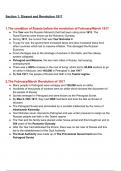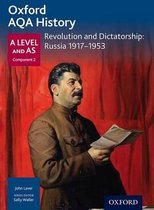Section 1: Dissent and Revolution 1917
1.The condition of Russia before the revolution of February/March 1917
● The Tsar was the Russian Monarch that had been ruling since 1613. The
Tsars/Tsarinas were known as the Romanov Dynasty.
● During 1917, the current Tsar was Tsar Nicholas II
● To pay for war, the government increased taxes and also increased loans from
other countries which led to massive inflation. This damaged the Russian
Economy
● Food shortages due to the shortage of workers in the fields, and the railway
system collapsed.
● Petrograd and Moscow, the two main cities in Russia, had soaring
unemployment
● There was a 300% increase in the cost of living, which led to 30,000 workers to go
on strike in Moscow, and 145,000 in Petrograd in Jan 1917
● By Feb 1917, the people of Russia lost faith in the Tsarist regime
2.The February/March Revolution of 1917
● Many people in Petrograd were unhappy and 150,000 went on strike.
● Hundreds of thousands of workers went on strike which showed the discontent of
the people of Russia
● Soviets emerged in Petrograd and were known as the Petrograd Soviet.
● By March 10th 1917, they had 3000 members and took the title as Soviet of
Workers
● The Petrograd Soviet was dominated by a socialist intellectual by the name of
Alexksandr Kerensky
● Tsar Nicholas never returned to Petrograd and was under pressure to resign as the
Russian people lost faith in the Tsarist regime
● The Tsar and his family were placed under house arrest and this brought an end to
304 years of the Romanov Dynasty
● After the Tsar had abdicated the throne, there was no set ruler of Russia and this
led to the establishment of the Dual Authority
● The Dual Authority was made up of The Provisional Government and the
Petrograd Soviet
, ● The Provisional Government was made up of the influential elites and those who
had formerly favoured constitutional monarchy. These people were the liberals,
moderate socialists and the Kadets
● The PG were legitimate and set themselves up in the right wing of the Duma
● The Petrograd Soviet were made up of the workers, soldiers and the peasants
● They also had Mensheviks, Socialist Revolutionaries and a small number of
Bolsheviks
● The PG and the Petrograd Soviet agreed to govern Russia
● The PG had made promises where there would be general amnesties for
prisoners, civil liberties, and freedom to organise trade unions and to strike. Also,
there would be an election of a Constituent Assembly to determine Russia’s future
● The Dual Authority had many disagreements. For example, the PG wanted to win
the war as quickly as possible, however the Soviets wanted the war to be ended.
● In July 1917 Lvov was replaced by Kerensky as the chairman of the PG,
effectively the Prime Minister
● The war started to become increasingly unpopular but the Russians felt bound due
to the alliance with Britain and France
● Elections were constantly postponed making the PG very undemocratic
● It was virtually impossible to get anything done due to many disagreements in the
Dual Authority
3.Developments between the revolutions of 1917
● During Feb/March 1917, the Bolsheviks were a small party with 23,000 members
and 40 representatives in the Soviet.
● All major leaders were in exile such as Lenin but the first to return was Kamenev
and Stalin, who took over the party’s newspaper Pravda.
● Lenin’s return was key as the Bolsheviks began to forge their own path, as
opposed to the PG, who wanted the continuation of war.
● Lenin made it clear that the aim of the Bolshevik Party was a second revolution.
● Mensheviks and many Bolsheviks believed that there should be a bourgeois
revolution however Lenin disagreed as he believed the middle class were too
weak.
● Lenin also believed that most of Europe was on the brink of socialist revolution.
● Lenin’s ideology was in his April Theses. These stated that the war should be
brought to an immediate end, power should be transferred to the Soviets and all
land should be taken over by the state and re allocated to peasants
, ● Not everyone at first accepted Lenin. Some Bolsheviks feared Lenin had grown out
of touch and his proposals would do more harm than good
● Mensheviks feared Lenin would undermine them and Lenin’s call to oppose the
PG was seen as unrealistic by some
● Lenin got his way through sheer personality alone. His skills of persuasion, tactful
retreat and threats of resignation played an integral role
● By the end of April, Lenin won a majority of the Central Committee of the
Bolshevik Party.
● July Days: The workers of Petrograd set up armed demonstrations against the
Provisional Government.
● The PG, who were supported by the Mensheviks and the SRs, crushed the
demonstrations.
● This led to a temporary decline of Bolshevik influence, and Lenin and Stalin
fled.
● Bolshevik propaganda was burned, Kamenev and Trotsky were imprisoned and
Lenin’s reputation fell.
● On the 8th of July 1917, Kerensky replaced Lvov as the Prime Minister
● Kornilov Affair: Kornilov wanted to create a military dictatorship but was stopped
by Kerensky. He released imprisoned Bolsheviks and provided workers with
weapons. Kornilov’s supply lines were cut and the coup leaders were arrested.
● The Bolshevik party members grew from 23,000 to 200,000 by the beginning of
October, producing 41 newspapers and 10,000 Red Guards
● Kamenev and Zinoviev were against revolution as they believed Russia was not
economically ready
● The Central Committee of the Bolshevik party controlled 200,000 Red Guards,
60,000 Baltic sailors and 150,000 soldiers.
● A state of mutiny erupted and armed revolution was established before the
Bolshevik revolution officially began on the 25th October 1917.
4.The October/November 1917 Revolution
● Kerensky seemed almost powerless to stop the Bolshevik assault
● He first ordered for the printers of the Bolshevik newspapers to cease activities,
but this failed due to the loyalty of the Bolsheviks
● This gave the Bolsheviks an excuse to act
● 24th October: 5000 soldiers and sailors from Kronstadt moved to the city.
Bolshevik Red Guards took over government buildings and positions in Petrograd.
Eg post office, railway stations, bridges, power stations, news agencies
, ● 25th October: Red Guard soldiers surrounded the Winter Palace.
● 26th October: Announced the seizure of the Winter Palace. Lenin’s decree on
peace issued
● 27th October: Decree on Land issued. Sovnarkom was created which included
the Bolsheviks with Lenin becoming the chairman.
● Trotsky claimed that only 25,000 to 30,000 people were involved which accounted
for 5% of the total workers.
● There was very little fighting and records suggest there was no more than 5 deaths
● Sovnarkom: The Soviet of People’s Commissars. Lenin had no intention to share
power and they met once or twice a day. Lenin sidelined the PG. The Soviet met
less frequently and their power was undermined.
● The Bolshevik position appeared weak as the Bolsheviks had no control in the
countryside, where many people lived.
● Kerensky’s force set up a new headquarters in Gatchina.
● 29th October: An army rising against the Bolsheviks which was easily defeated by
the Red Guards.
● 31st October: Bolsheviks took control of Baku in 17 provincial capitals
● 2nd November: Kerensky’s forces were defeated
● 3rd November: The Kremlin in Moscow was taken. Lenin issued an ultimatum
which led to Kamenev, Zinoviev, and Rykov all left.
● 5th November: Lenin proclaimed victory in the revolution.
● Lenin also issued many decrees such as the Workers’ Decree. This allowed for
there to be an 8 hour work day
● Lenin also issued the decree on peace which put an end to war. The Decree on
Land abolished private ownership. Lenin also issued a decree to outlaw sex
discrimination, which gave women equal rights.
● Lenin issued the decrees on the Church which nationalised church land.
Section 2:Bolshevik Consolidation 1918-1924
5.The consolidation of the Communist Dictatorship
● Lenin believed the Bolsheviks were acting in the interests of the working class and
this was all the authority he needed
● Kerensky previously postponed many elections, however, Lenin permitted for
elections to go ahead.
● There were over 41 million votes .





